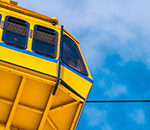When it comes to capturing good action shots—whether a teen’s latest skateboard maneuver or Fido’s latest antic—one of the most important photography basics to consider is shutter lag.
More accurately called “processor lag,” this is the time that passes between the moment you press the shutter release button to the moment the camera actually gets the shot and you see that green light. Press too soon, and you end up with something completely different than you’d expected.
In spite of all their advantages, compact digital cameras are slower than film cameras, some more than others. This article provides some tips for dealing with this lag, as well as tips for just generally taking some exciting and memorable action pictures.
1. Be Ready to Shoot
While you can’t know if your child is going to make that soccer goal, try to anticipate when then things are most apt to happen. Even professional sports photographers with speed-of-lightning cameras try to anticipate the action, just so they can be in the right spot and point the camera in the right direction.
To better anticipate the likelihood of that great shot, gain a basic understanding of what/whom you are photographing. In other words, if you plan to photograph your child’s soccer game, learn the rules of the game. If your child’s performing in the Nutcracker, watch a rehearsal or two.
2. Shop Around Before Purchasing a Compact Digital
Unfortunately, there isn’t just one camera spec that will tell you how fast the camera will capture the picture from the time you press that button. Other factors can slow down the processing too, like the quality of the sensor and in dim lighting, the ISO setting. So check out what others are saying at photography forums and honest review sites, and read all the specs available.
3. Spring for a DSLR (Digital Single-Lens-Reflex)
They’re more expensive than compacts, but they’re FAST. These cameras do not have shutter-lag issues, and if you’re shooting action indoors, you can ramp up the ISO without your photos being marred by the digital noise that you’ll get when doing the same with a compact.
Tips for Great Action Photos
Whether you have a compact, DSLR, point-and-shoot film camera or camera phone, try these professional tricks.
1. Zoom in on Faces. Don’t always focus on the action. Capture those expressions of determination, triumph and even defeat (especially if it’s an opponent!).
2. Tell a Story. Look for shots that tell a story of the event. For example, begin with a shot of the team’s huddle or your fellow paddlers launching their rafts.
3. Freeze! To freeze the action, set your camera to sports mode or set your Shutter Speed Priority to a high setting. For an example of the difference in settings: freezing action in a soccer game requires a shutter speed in the range of 1/250 to 1/500, while freezing the tiny movements of a pet that appears to be sitting still, requires 1/125.
4. Blur the Background. Take a cue from the sports photographers, and blur the background by decreasing the camera’s depth of field. If using a camera that has Aperture Priority, you can do this by simply decreasing the f-stop number. The lower the f-stop, the more background blur. Want to capture the crowd cheering?
5. Pan. This is a good alternative for digital compact users where dim light underexposes photos shot with sports mode/fast shutter speed. Panning works with automatic focus, but it only works when the action is moving in a fairly straight line. Here’s how to pan:
- Set the camera to Autofocus.
- With feet planted firmly on the ground, move the upper half of your body while following the subject with your camera.
- Just before the anticipated action that you want to capture occurs, start pressing the shutter release button and continue following the subject until you’ve pressed the button all the way down and the camera gets the shot.
- Autofocus too slow on your camera? Focus on an area of contrast, such as the number on a uniform. Autofocus works faster with contrast.
Experiment with panning to get various effects. You might want to show some blur in the action to emphasize the speed of movement, such as with a race car.
Whether of a sporting event or your dog, action shots are really fun to take once you get the hang of it. And once you master the digital photography basics (like compensating for shutter lag) it makes it all the more fun.
About the Author
Autumn Lockwood is a writer for Your Picture Frames. Your Picture Frames offers a large selection of quality picture frames in a wide variety of styles, sizes and colors. Shop online and see our selection of quality silver picture frames now.
Like This Article?
Don't Miss The Next One!
Join over 100,000 photographers of all experience levels who receive our free photography tips and articles to stay current:








Thanks! This helped.